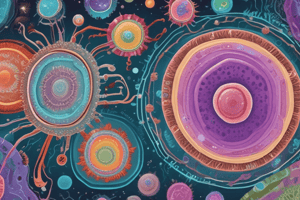Podcast
Questions and Answers
What is the primary function of plasmid DNA in prokaryotic cells?
What is the primary function of plasmid DNA in prokaryotic cells?
- It forms the nuclear membrane.
- It serves as the main genetic material.
- It facilitates the production of ribosomes.
- It confers unique phenotypic traits such as antibiotic resistance. (correct)
Which statement accurately describes the genetic material in prokaryotic cells?
Which statement accurately describes the genetic material in prokaryotic cells?
- It is always linear and organized in multiple chromosomes.
- It consists of a single circular chromosome and may have additional plasmids. (correct)
- It is embedded within membrane-bound organelles.
- It is wrapped in a well-defined nuclear membrane.
Which of the following structures is unique to prokaryotic cells?
Which of the following structures is unique to prokaryotic cells?
- Nucleus
- Mitochondria
- Endoplasmic reticulum
- Mesosomes (correct)
What type of bacteria is characterized by a rod-like shape?
What type of bacteria is characterized by a rod-like shape?
What component do prokaryotic cells lack compared to eukaryotic cells?
What component do prokaryotic cells lack compared to eukaryotic cells?
Which of the following statements about mycoplasma is correct?
Which of the following statements about mycoplasma is correct?
How do prokaryotic cells mainly reproduce?
How do prokaryotic cells mainly reproduce?
Which of the following structures are present in prokaryotic cells?
Which of the following structures are present in prokaryotic cells?
What role do inclusions serve in prokaryotic cells?
What role do inclusions serve in prokaryotic cells?
Flashcards
Prokaryotic Cells
Prokaryotic Cells
Single-celled organisms lacking a true nucleus and membrane-bound organelles. Examples include bacteria, blue-green algae, and mycoplasma.
Bacillus
Bacillus
Rod-shaped bacteria.
Coccus
Coccus
Spherical bacteria.
Vibrio
Vibrio
Signup and view all the flashcards
Spirillum
Spirillum
Signup and view all the flashcards
Cytoplasm
Cytoplasm
Signup and view all the flashcards
Genomic DNA
Genomic DNA
Signup and view all the flashcards
Plasmids
Plasmids
Signup and view all the flashcards
Mesosomes
Mesosomes
Signup and view all the flashcards
Study Notes
Prokaryotic Cells
-
Prokaryotic cells, exemplified by bacteria, blue-green algae, mycoplasma, and PPLO, are generally smaller and reproduce faster than eukaryotic cells.
-
Prokaryotes exhibit various shapes: bacilli (rod-like), cocci (spherical), vibrio (comma-shaped), and spirilla (spiral).
-
Despite diverse shapes and functions, prokaryotic cell organization is fundamentally similar. All prokaryotes (except mycoplasma) have a cell wall surrounding their cell membrane.
-
The cytoplasm is the fluid matrix within the cell.
-
Prokaryotes lack a defined nucleus. Their genetic material is naked DNA, not enclosed within a nuclear membrane.
-
Bacteria possess a single circular chromosome (genomic DNA) but may also have small, circular DNA pieces called plasmids.
-
Plasmids confer unique traits like antibiotic resistance to the bacteria
-
Eukaryotic cells, in contrast, possess a nuclear membrane.
-
Ribosomes are present in both prokaryotic and eukaryotic cells.
-
Prokaryotes have unique inclusions. A specialized membrane infolding called a mesosome is another characteristic feature.
Studying That Suits You
Use AI to generate personalized quizzes and flashcards to suit your learning preferences.



